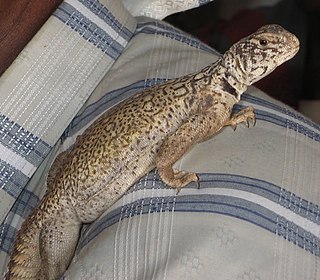
Acanthocercus is a genus of lizards in the family Agamidae. The genus is endemic to Africa and the Arabian Peninsula.

Laudakia is a genus of lizards, commonly known as Asian rock agamas, in the family Agamidae. The genus is found mostly in Asia, with some species in Southern Europe.

The Sinai agama is an agamid lizard found in arid areas of southeastern Libya, eastern Egypt, Israel, Jordan, Syria, Saudi Arabia, Oman, eastern Sudan, Ethiopia, Eritrea, and Djibouti.

Pristurus carteri, commonly known as Carter's rock gecko or Carter's semaphore gecko, is a species of gecko, a lizard in the family Sphaerodactylidae.
Stenodactylus slevini, also known commonly as Slevin's sand gecko or Slevin's short-fingered gecko, is a species of lizard in the family Gekkonidae. The species is native to Western Asia.

Bosc's fringe-toed lizard or Bosk's [sic] fringe-fingered lizard is a species of lizard in the family Lacertidae. The species is endemic to North Africa and Western Asia. Three subspecies are sometimes recognised; A. boskianus boskianus, from Lower Egypt; A. boskianus euphraticus from Iraq; and A. boskianus asper from the rest of the range; however this division is unsatisfactory because each subspecies has much variation and the differences between them are not consistent.

Uromastyx ornata, commonly called the ornate mastigure, is a species of lizard in the family Agamidae.

Stenodactylus doriae, commonly known as Doria's comb-fingered gecko and the Middle Eastern short-fingered gecko, is a species of lizard in the family Gekkonidae. The species is native to Western Asia.

The black-necked agama or southern tree agama, is a species of tree agama that is native to East, Central and southern Africa. Its largest continuous range is in southeastern Africa, and it occurs at high densities in the Kruger National Park.
Acanthodactylus haasi, also known commonly as Haas' fringe-fingered lizard or Haas's fringe-toed lizard, is a species of lizard in the family Lacertidae. The species is endemic to the Arabian Peninsula.
Acanthodactylus masirae, also commonly called the Masira fringe-fingered lizard or the Masira fringe-toed lizard, is a species of lizard in the family Lacertidae. The species is endemic to Oman.

Acanthodactylus schmidti, also known commonly as Schmidt's fringe-fingered lizard or Schmidt's fringe-toed lizard, is a species of lizard in the family Lacertidae. The species is endemic to Western Asia.
Acanthodactylus tilburyi, known commonly as Tilbury's fringe-fingered lizard, Tilbury's fringe-toed lizard, and Tilbury's spiny-footed lizard, is a species of lizard in the family Lacertidae. The species is endemic to the Middle East.

Hemidactylus yerburii, also known commonly as the southern leaf-toed gecko, Yerbury's gecko, and Yerburi's leaf-toed gecko, is a species of lizard in the family Gekkonidae. The species is native to Western Asia.
Scortecci's sand gecko, also known commonly as Scortecci's dwarf gecko, is a species of lizard in the family Gekkonidae. The species is endemic to the Arabian Peninsula.
Philochortus neumanni, known commonly as Neumann's orangetail lizard, is a species of lizard in the family Lacertidae. The species is endemic to the Arabian Peninsula in Western Asia.

Acanthocercus yemensis is a species of lizard in the family Agamidae. It is a small lizard found in Yemen and Saudi Arabia.
Agama boulengeri, also known commonly as Boulenger's agama, is a species of lizard in the family Agamidae. The species is native to western Africa.

Arabian toad-headed agama is a species of agamid lizard found in Saudi Arabia, Qatar, United Arab Emirates, Oman, Iran, and Jordan.

Uromastyx benti, also known commonly as Bent's mastigure and the Yemeni spiny-tailed lizard, is a species of lizard in the family Agamidae. The species is native to the southeastern Arabian Peninsula.















